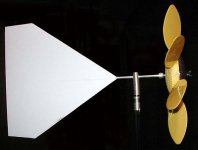Calvin,
I am a novice as well but these are my thoughts.
I certainly thought along the same lines until I saw a few situations that got me to thinking.
I usually use a surveyor tape tail unless it is windy enough to blow them out flat then I switch to a sail tail. At times I have been at the local range early in the morning at a time when the wind hasn't picked up yet. The flags would just sit there and do nothing for most of the time.
As the wind started to think about getting going it isn't unusual to see the whole flag assembly turn direction even though the tail didn't flutter and the prop didn't turn, and the BRT props turn easily and the surveyor tape blows out easily.
I guess the sail area of the vane compared to the flag assembly weight is enough such that the whole thing can move before there is enough wind pressure on the small area of the tail to make the tail move. The tail is light but it doesn't offer much area for the wind to push on, small area = small force for a given wind pressure.
It the flag assembly is light, well balanced, pivots freely and is positioed on a nice vertical pole the thing will flip around without much moving air mass at all.
I know that I have at times in practice ignored a switch when there was so little wind that the props weren't turning because it seemed like there couldn't be enough wind to matter !! OOPS !! If there is enough wind to pivot the whole asembly but not move the tail or prop it is still probably enough air movement to shift the bullet as well.
If you have a heavy daisy wheel and weighty sail tails will they move well enough to see those small changes when the conditions are very light or change fast enough when the conditions are very changeable ??
The sail tails work well when the wind is up but for lighter winds I like the surveyor tape. In combination with a fast acting light prop you can see little things that may be missed otherwise.
I know at a recent shoot I was having issues with a breeze that I couldn't see. I had sail tails on. I was doing my best to shoot in the same condition but I was getting a bit of horizontal that was opening up groups. I decided to watch that actual speed of the prop rather than just the angle of the vane and the sail tail angle. I noticed that the wind speed was changing, the prop was speeding up or slowing down, before it was obvious from the angle of the tail angle. I watched the vane direction, tail angle and fired when the prop speed looked right and shot my best group of the morning.
Down here the Aussie BRT flags are the most common or home made versions of something similar. I haven't been to many shoots or met all the guys here but I have not seen a single daisy wheel anywhere ! I have been told we shoot in much more fickle winds than happen at many of the USA ranges. We don't seem to get winds that will hold for long and a nice responsive flag helps pick up the changes soon enough to avoid a horror story on the target .... usually !!
Like I said, I don't know much but that is my contribution to this discussion. I hope it beats tuners and personal digs !!

Bryce




